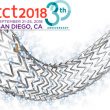Coronary perforation has an incidence of 0.5% and it is associated with a 13-fold increase in in-hospital events and a 5-fold increase in 30-day mortality. This event is so catastrophic that its management has become indispensable knowledge to all interventional cardiologists. This accident is most frequently provoked by artery over-dilation caused by a balloon or<a href="https://solaci.org/en/2018/11/06/practical-management-of-coronary-perforations/" title="Read more" >...</a>
Safety of Early Carotid Artery Stenting in Symptomatic Patients
This work shows the safety of carotid artery stenting within 14 days of a stroke and, so far, this is the largest series of symptomatic patients published by an institution. The exact moment to conduct this procedure after an acute stroke is still controversial, although most publications so far have favored early endarterectomy over early angioplasty.<a href="https://solaci.org/en/2018/10/12/safety-of-early-carotid-artery-stenting-in-symptomatic-patients/" title="Read more" >...</a>
The 10 most read articles of September
1- High-Sensitivity Troponins Turned All Events into Infarctions; the 4th Universal Definition Clarifies Things Myocardial infarction or myocardial injury? The Fourth Universal Definition of Myocardial Infarction (an update of the 2012 version) is here to clarify that not all cases of elevated cardiac troponin values are acute myocardial infarctions. Read more 2- A Simple<a href="https://solaci.org/en/2018/10/09/the-10-most-read-articles-of-september/" title="Read more" >...</a>
TCT 2018 | ABSORB IV: Much Life Left for Bioresorbable Scaffolds
Previous studies have documented higher rates of adverse events with bioresorbable scaffolds (ABSORB) compared with metallic drug-eluting stents (DES). However, these studies included lesions smaller than recommended for these scaffolds and a suboptimal implantation technique. The ABSORB IV study, presented by Dr. Stone at TCT 2018 and published simultaneously in The Lancet, randomized patients to polymeric everolimus-eluting scaffold Absorb<a href="https://solaci.org/en/2018/10/08/tct-2018-absorb-iv-much-life-left-for-bioresorbable-scaffolds/" title="Read more" >...</a>
TCT 2018 | ReCre8 Trial: Permanent Polymer and Zotarolimus vs. Polymer-Free Amphilimus
Polymer-free amphilimus-eluting stents are a novel technology combining sirolimus and long-chained fatty acids. This enhances the uptake of antiproliferative agents and may be associated with lower restenosis, particularly among patients with diabetes. The new device includes abluminal reservoirs filled with the drug; in consequence, there is no need for polymer. This work compares this new<a href="https://solaci.org/en/2018/10/08/tct-2018-recre8-trial-permanent-polymer-and-zotarolimus-vs-polymer-free-amphilimus/" title="Read more" >...</a>
TCT 2018 | MAIN COMPARE: Angioplasty vs. Surgery for Left Main Coronary Artery Disease at 10 Years
Several studies (some of them recent, some of them not so much so) have compared left main coronary artery angioplasty and myocardial revascularization surgery. Combined, these works compose a large corpus of evidence, but follow-up has not gone beyond 5 years in any case. The main aim of this study (presented at TCT 2018 and published simultaneously<a href="https://solaci.org/en/2018/10/08/tct-2018-main-compare-angioplasty-vs-surgery-for-left-main-coronary-artery-disease-at-10-years/" title="Read more" >...</a>
TCT 2018 | BIONYX: Durable Polymer-Coated vs. Ultrathin-Strut, Bioresorbable Polymer-Coated DES
This work, presented at TCT 2018 and published simultaneously in The Lancet, is the first randomized study comparing a zotarolimus-eluting stent with a new thin-strut structure and limited radiographic visibility (Onyx), and a bioresorbable polymer-coated sirolimus-eluting stent (Orsiro). Onyx was developed to improve visibility while reducing strut thickness. To that end, a dense platinum–iridium core and<a href="https://solaci.org/en/2018/10/08/tct-2018-bionyx-durable-polymer-coated-vs-ultrathin-strut-bioresorbable-polymer-coated-des/" title="Read more" >...</a>
TCT 2018 | RESET: Everolimus DES vs. Sirolimus First Generation DES at Long Term
This study had published thrombosis and revascularization rates at one year after stenting, but today one year seems rather short, which is why this cohort was followed up for 5 to 7 years more, to be able to properly assess the differences between first and second generation DES. There were no significant differences a t<a href="https://solaci.org/en/2018/10/05/tct-2018-reset-everolimus-des-vs-sirolimus-first-generation-des-at-long-term/" title="Read more" >...</a>
TCT 2018 | SYNTAXES: 10 Year Follow Up is ‘Trendy’
The SYNTAX trial had a 5-year follow-up, but the SYNTAXES (“ES” for extended survival) was specifically designed to find out comparative mortality of both treatments (PCI or surgery) at 10 years in patients with three vessel and/or left main lesions. This study retrospectively compared survival data at long term of 897 patients randomized to surgery<a href="https://solaci.org/en/2018/10/05/tct-2018-syntaxes-10-year-follow-up-is-trendy/" title="Read more" >...</a>
TCT 2018 | SORT OUT IX: Polymer-Free DES with Ultra-Thin Struts vs. Bioresorbable Polymer- Based DES
Polymer persistence in 1st and 2nd generation DES meant to allow drug release has been associated with a chronic inflammatory response that might be associated to restenosis, neo atherosclerosis and stent thrombosis. This is the rationale behind the development of polymer free and bioresorbable polymer-based DES. They have both been compared against permanent polymer DES,<a href="https://solaci.org/en/2018/10/03/tct-2018-sort-out-ix-polymer-free-des-with-ultra-thin-struts-vs-bioresorbable-polymer-based-des/" title="Read more" >...</a>









